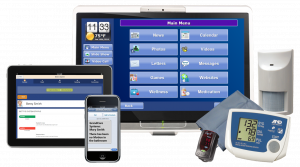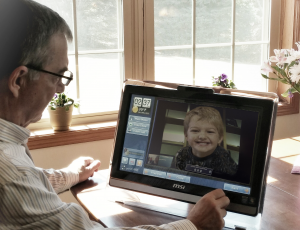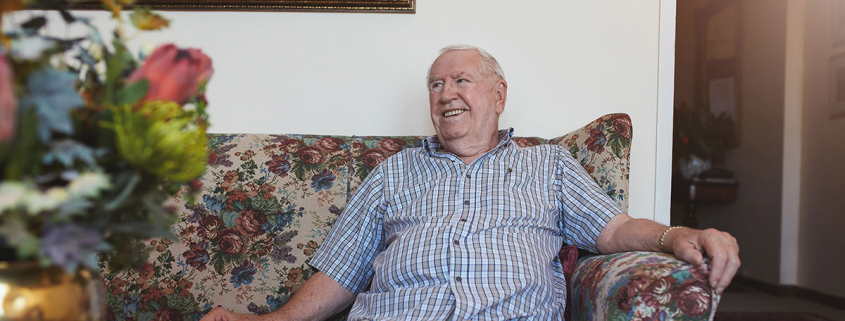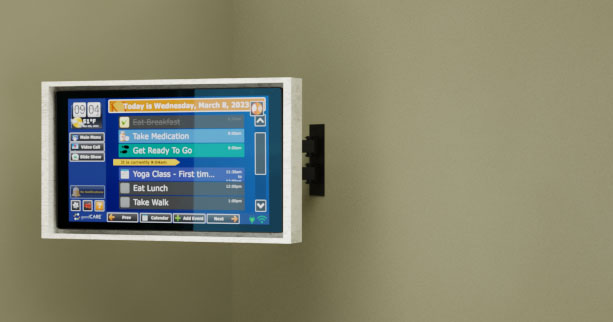What to Look for in a Senior Home Monitoring System
Updated as of Jan 2022: Senior home monitoring has never been more critical than it is now, during the COVID-19 pandemic. Not only do you have all the regular concerns, but now you need a way to keep in touch even when you can’t visit for infection control reasons. Your monitoring system should emphasize video calls–easy ones that people over the age of 85 can use, even if they’ve never used a computer. No usernames, passwords, addresses to remember. Just touch and talk. Read on to find out more about what to look for in a senior home monitoring system.
Seniors who want to remain independent in their homes are finding that they can. With the advances in technology tools, seniors are discovering that remaining in their homes can be a safe, healthy and happy option. This is great news to the many seniors (more than 75% according to an AARP survey) who would prefer to stay home.
These days, as life expectancy increases, 80 is the new 60, and the age at which seniors identify as elderly continues to be pushed back. With the right technology, seniors can stay connected, healthy, and independent well into their later years.
But, not all senior home care technology is created equal, and not all systems offer the same functionality. If you’re shopping for technology devices for elderly home care, how do you make the best choice for your family? GrandCare has taken the guesswork out of it for you.
Here is our list of the 10 most important features to look for when buying a monitoring system for elderly in the home:
1. Social Connection
Seniors often suffer from loneliness, isolation and depression, but technology can be a great solution. Look for a system that allows communication between seniors and their families and friends. Some systems allow easy photo sharing, chatting and messaging, which can help Grandma stay in the loop, even from a distance.
2. Medication Reminders
It’s not unusual for the list of medications we need to increase as we age, and the schedule for taking them can get complicated. In fact, medication noncompliance is a leading driver to falls and hospitalizations. Timed reminders of what to take, and when, can be a big help. Family members, or even seniors themselves, enter the dosage information into caregiver management software, and reminders can appear on a screen, in a text message or email, or over the phone. More complete systems can even send follow-up reminders, or alerts to let you know if reminders haven’t been acknowledged.
3. Daily Check-in
One of the simplest ways to make sure that everything is okay is a daily check-in. It’s an easy way to let everyone know that Mom or Dad are up and moving in the morning, and doing fine. Some home care monitoring systems use a check-in button or motion sensors and even video check-ins. An alert notification can let people know if a check-in has been missed, and to follow up by phone or with a visit.
4. Help Buttons
The stereotype of the help button is something that can call emergency services and an ambulance will shortly arrive. The problem is that many seniors avoid using them for just that reason, even when they should. Buttons that can be used to notify family, friends, or neighbors are a simpler alternative that appeal to seniors and are more likely to be used as intended. Some systems work with a wearable pendant, or a push button device. Others provide an onscreen button. The best will offer a variety of these options.
5. Remote Activity Monitoring
Maybe you’re worried about whether your mom is getting into the kitchen to make herself meals regularly, or that she didn’t get out of bed. Maybe you’re worried that your dad is restless and up all night, or that he’s spending too much time in his favorite chair. Activity monitoring, using motion sensors, bed or chair pads, is an unobtrusive way to make sure that your loved one is safe and following their normal routines. When something has changed, an alert notification can let you know, so you can follow up if you need to.
6. Door Alarms
If you’re worried that a loved one might be confused and a wander risk, door controls can give you peace of mind. If an outer door opens in the middle of the night, the home monitoring system should be able to alert you, or a neighbor close by who can intervene quickly. You can also be reminded if doors are inadvertently left open.
7. Health Monitoring
If your loved one has health concerns, early intervention is key. A good home monitoring system can help them to self-track vitals, such as blood pressure, blood glucose, weight, temperature, etc. Unusual readings can trigger an alert, so you can get involved before it becomes a crisis. Reminders help seniors remember to take their readings on a timely basis. It’s helpful if the system collects and trends the data. This type of reporting can provide helpful information for care providers, who can see trends and changes in health.
8. To-Do Lists and Cognitive Assists
Calendars and to-do lists help seniors remember their appointments. Some monitoring systems for the elderly have a resident empowerment side which provides daily schedules, appointments and checklists of daily routines to help seniors who want to remain independent in the home. This feature gives a little extra reminding on routine tasks.
9. Video Calling
Video communication is a great way for seniors to stay in touch with family. It’s becoming an increasingly viable way to communicate with healthcare providers, especially if travel is difficult. It’s important that the video function is easy-to-use, especially for people who aren’t technical. Home monitoring systems with video must be closed and designed for safety, to prevent unwanted, predatory calls. Ask if your system is HIPAA-compliant, so that it can be used for telehealth and healthcare communications.
10. Designed for Seniors
The best systems have an interface that’s easy for seniors to use. Systems that are well-designed for older eyes use large fonts, with high-contrast displays, and easy-to-operate buttons, keyboard, and volume control. The caregiver management software should also be simple to use, and easy to set up, and must include alert capabilities. A caregiving app for cell phones has become a must-have for families and caregivers.

GrandCare Homecare Technology for Seniors
Founded in 2005, GrandCare is the most comprehensive and long-standing pioneer in the senior home care monitoring and technology industry. Our solutions help seniors who are seeking to remain independent, manage chronic conditions, and avoid potential hospital visits.
GrandCare’s touchscreen reminds the resident when it’s time to take meds, or when it’s time to take vital readings, along with to-do checklists, prompts and other cognitive assists. The one-touch HIPAA-compliant video chat and other socialization/communication/entertainment features help seniors stay connected with family.
Wireless activity tracking sensors and Bluetooth health monitoring devices report automatically to the system, where reports and graphs show data and trends. Designated providers/family can access the information and set up rules to be alerted if something seems amiss (e.g. excessive weight gain, med noncompliance, lack of motion, too much motion, etc.)

GrandCare’s one-touch video calling
If you’re shopping for a senior home monitoring solution, check out GrandCare. Our systems include all ten features above, in an easy-to-use, affordable home-based technology.
Want to find out more? Contact the leader in the field.




